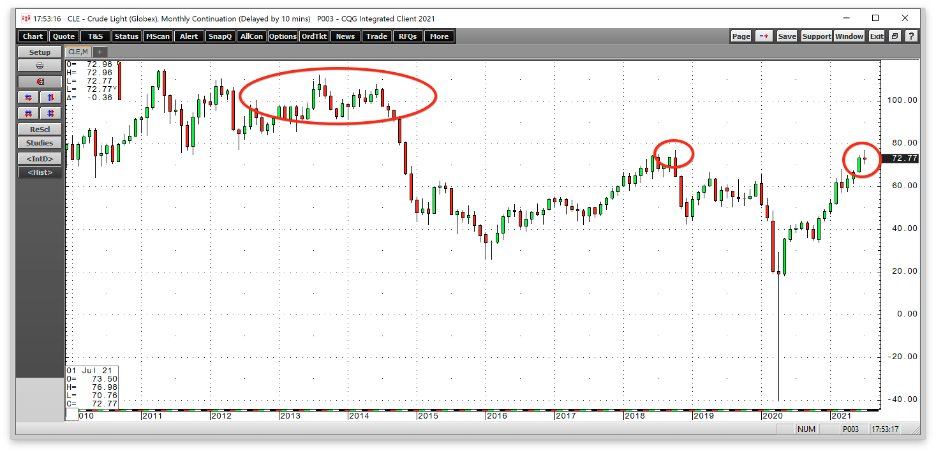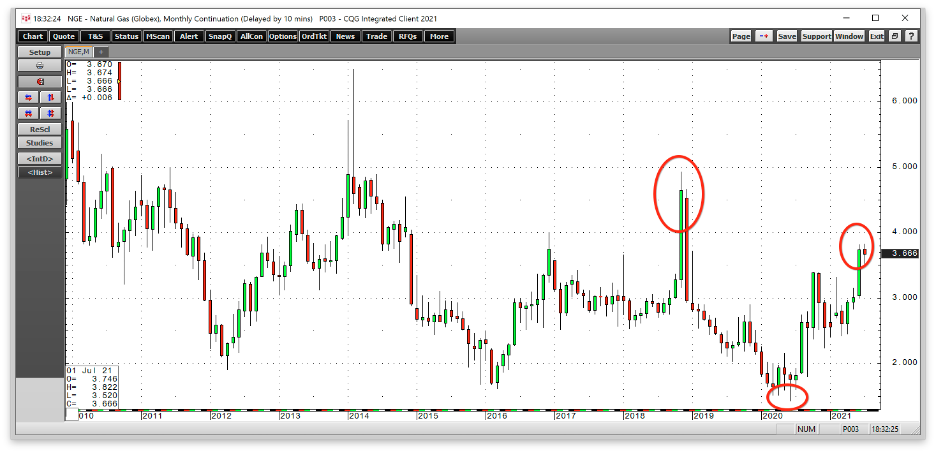U.S. stocks rise on Fed cut bets; earnings continue to flow
This article was written exclusively for Investing.com.
- US energy policy handed a gift to the international oil cartel - Energy demand is booming
- Russia became the most potent force starting in 2016
- The UAE balks at the biannual meeting
- A division between the UAE and the rest of OPEC began before the meeting - The cartel is doing its best to shoot itself in the foot
- OPEC’s non-action leaves the world wondering and production policy in question - Three reasons the oil price may still head a lot higher
The biannual meeting of the international oil cartel is in the early summer and winter each year. In 2021, the first gathering was on July 1 and 2. OPEC ministers came together to discuss the production cuts in place since the beginning of the global pandemic that caused energy demand to evaporate, sending the energy commodity to historic lows in April 2020. Nearby NYMEX crude oil futures fell below zero and to under negative $40 per barrel on April 20, 2020. Brent futures fell to $16 per barrel, the lowest price of this century.
The NYMEX WTI crude oil fell further as it is landlocked crude oil for delivery at the pipeline in Cushing, Oklahoma. With nowhere to store the petroleum, the expiring futures contract became a bearish hot potato. Brent fell but only reached $16 per barrel because it is a seaborne crude oil. Tankers on the high seas provided some storage capacity that kept the price in positive territory.
Meanwhile, both oil benchmarks have been making higher lows and higher highs since April 2020. In June, WTI prices eclipsed the $70 per barrel level for the first time since October 2018. The oil ministers met in early July to discuss production cut levels. The meeting’s outcome was a disaster, which is nothing new for the cartel. OPEC’s decision to abandon production policy in early 2020 contributed to the price plunge. The cartel has not learned from its past mistakes. However, this time, the landscape is far different than during the beginning of the global pandemic.
US energy policy handed a gift to the international oil cartel - Energy demand is booming
On Jan. 20, 2021, Joe Biden became the forty-sixth US President. On inauguration day, one of his first executive orders was to cancel the Keystone XL pipeline project that carries crude oil from the oil sands in Alberta, Canada, to Steele City, Nebraska, and beyond to the NYMEX delivery point in Cushing, Oklahoma. In May, the Biden administration banned fracking and drilling for fossil fuels on federal land in Alaska.
The moves were not unexpected as the President campaigned on a platform to address climate change by shifting US energy policy to a cleaner and greener path. However, the robust demand for oil and gas as vaccines creates herd immunity and reduces the risk of COVID-19 has accelerated gains in hydrocarbon futures markets. Crude oil for nearby delivery has rallied to over $74 per barrel, with the NYMEX futures reaching the highest price since 2014 last week.
Source: CQG
The monthly chart highlights last week’s most recent high at $76.98 per barrel, eight cents above the October 2018 peak and the highest level since November 2014. In 2014, crude oil traded north of $100 per barrel, which is the next level of long-term technical resistance. The August futures were at over the $74 level on Wednesday, July 14.

Source: CQG
The monthly NYMEX natural gas chart shows the rally from a quarter-of-a-century low at $1.432 per MMBtu in June 2020 to last week’s high at $3.822. Natural gas was trading at the highest price since December 2018, with the next technical resistance level at the November 2018 $4.929 per MMBtu high. Natural gas was sitting near the $3.75 level on July 14.
Other energy commodities have also reached multi-year highs over the past weeks and months. Ethanol was over $2.30 per gallon wholesale, the highest price level since 2014. Thermal coal for delivery in Rotterdam at $130 per ton is sitting at its highest price in a decade since 2011.
While growing energy demand is pushing prices higher, the green shift in US energy policy and inflationary pressures exacerbates the rallies. In March 2020, US daily crude oil output rose to a record 13.1 million barrels per day. According to the Energy Information Administration, output stood at 11.4 mbpd as of the week ending on July 9. According to the EIA and the American Petroleum Institute, crude oil inventories declined over the past seven consecutive weeks,
In natural gas, the EIA reported that inventories stood at 2.574 trillion cubic feet for the week ending on July 2, 17.6% below last year and 6.9% under the five-year average for the beginning of July.
The shift away from fossil fuels in the US and growing demand creates a potent bullish cocktail for crude oil, natural gas, and other energy commodities. The lack of coordinated production policy from OPEC+ should have been bearish news, but the prices remained near the recent highs in the aftermath of the cartel’s biannual meeting.
Russia became the most potent force starting in 2016
In 2016, when crude oil prices declined, the Russians became far more involved in coordinating policy with OPEC members. While Russia remains a nonmember, its influence has grown over the past years. OPEC hardly makes a move without consultation and cooperation from Moscow. In the past, any announcements on changes in production policy would come on the initial day of the meetings. Over the past five years, day one is reserved for the members, but announcements only come on day two or later after the Russian oil minister and President Putin put their stamp of approval on decisions. Russia’s sphere of influence has extended to the Middle East. The close relationship with Iran developed as both countries have provided support to Syrian leader Assad. Even the Saudis have strengthened ties with Moscow over the past years. The association has bloomed under the new US administration.
Meanwhile, Saudi Arabia and Russia favored a 400,000 barrels per day taper in the current production quotas, but that was not enough for the United Arab Emirates.
The UAE balks at the biannual meeting
Due out on Friday, July 2, the production decision did not come until Monday, July 5, as the UAE lobbied for a more substantial tapering of the cuts. The UAE’s relations with the US have strengthened over the past months. Moreover, the UAE established diplomatic and trading relations with Israel over the past year.
The UAE walked away from the negotiating table, creating the potential for a free for all of the output from OPEC members. However, crude oil rose in the immediate aftermath of the meeting in a counter-intuitive move. Ironically, the bearish prospects from the cartel led to the most recent high at $76.98 on NYMEX crude oil and $77.84 on Brent futures on July 6.
When a market rallies on bearish news, it is a sign of substantial underlying strength.
A division between the UAE and the rest of OPEC began before the meeting - The cartel is doing its best to shoot itself in the foot
The UAE’s ties to Israel and the US are likely a sticking point for the Iranians and Saudis. Moreover, the cartel had suffered for years under the weight of rising US shale production.
In March 2021, Saudi energy Minister Prince Abdulaziz bin Salman gleefully said US policy of “’Drill, baby, drill’ is gone forever.” The cartel members and Russia have been licking their chops as the price of crude oil rose over the past months. The proposed 400,000 barrel per day increase in production and taper in cuts from 2020 was likely just enough to increase output while squeezing the US and other consumers. OPEC’s mission is to adjust production policy to provide its members with the optimal financial result. Infighting between the UAE and other members is another example of the members shooting themselves in the foot, but so far, the bullish crude oil market is bailing them out. Had they reached an agreement at a 400,000-bpd taper for the coming months, the price would likely have moved higher than the current level.
OPEC’s non-action leaves the world wondering and production policy in question - Three reasons the oil price may still head a lot higher
OPEC cannot get its act together. With no agreement on production policy for the coming months, the cartel members appear to be on their own. While discussions will continue, the gulf between the UAE and other members, including Russia, could be too wide to bridge. The cartel’s future could hang in the balance of a compromise at a time when the United States handed the group the pricing power in the petroleum market on a silver platter.
Crude oil’s price action in the wake of OPEC’s discord is impressive. At least three factors could send the price a lot higher over the coming months and years:
- The Fed may continue to call inflationary “transitory,” “temporary,” or anything else other than what it is, the legacy of a tidal wave of central bank liquidity and a tsunami of government stimulus. Inflation is bullish for all commodities, and crude oil is no exception.
- The conflict between the UAE and other OPEC members and Russia is a microcosm of the turbulent state of the Middle East. The region is home to over half the world’s petroleum reserves. With US output declining because of the greener path for US energy policy, any events that disrupt supplies, refining, or logistical routes in the area could dramatically impact oil’s price. Crude oil has become a lot more sensitive to events in the Middle East with the Biden administration in the Oval Office.
- NYMEX crude oil futures moved marginally above the October 2018 to the highest price since 2014. The price remains a stone’s throw away from the highs, which could be a gateway to triple-digit oil prices.
OPEC tried to shoot itself in the foot at the latest biannual meeting, but US energy policy pushed the foot out of the line of fire. OPEC looks likely to squeeze US consumers with higher prices despite the cartel’s incompetence.
Meanwhile, on July 14, news that OPEC+ reached a provisional agreement to taper the production cuts by 400,000 bpd with a compromise that allows the UAE to increase output from 3.2 mbpd to 3.65 mbpd starting in April 2022 weighed on the oil futures market. While crude oil is overdue for a downside correction, the strength of demand is likely to lead to a higher low. US producers have been increasing output, but the shift in US energy policy likely created a supply ceiling as fossil fuel production runs contrary to the Biden administration’s green path.
